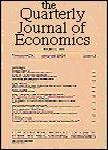-
作者:RIVERABATIZ, LA; ROMER, PM
作者单位:University of California System; University of California Berkeley
-
作者:CAPPELLI, P; CHAUVIN, K
作者单位:University of Kansas
-
作者:BARRO, RJ
-
作者:TVERSKY, A; KAHNEMAN, D
作者单位:University of California System; University of California Berkeley
摘要:Much experimental evidence indicates that choice depends on the status quo or reference level: changes of reference point often lead to reversals of preference. We present a reference-dependent theory of consumer choice, which explains such effects by a deformation of indifference curves about the reference point. The central assumption of the theory is that losses and disadvantages have greater impact on preferences than gains and advantages. Implications of loss aversion for economic behavio...
-
作者:MOSSER, PC
作者单位:Federal Reserve System - USA; Federal Reserve Bank - New York
摘要:The paper presents empirical tests of the (S, s) model of inventory behavior using aggregate retail trade data. Estimation and testing are based on the probability distributions of inventories derived by Caplin [1985]. The excess volatility of retailers' demand over their consumers' demand, and the forgetfulness of inventories under (S, s) are emphasized. Test results indicate that the time series properties of deliveries and sales are consistent with (S, s) and not a quadratic cost model. Fin...
-
作者:HALVORSEN, R; SMITH, TR
作者单位:Federal Reserve System - USA; Federal Reserve Bank - Kansas City
摘要:An empirical test of the theory of exhaustible resources requires an estimate of the time path of the shadow price of the unextracted resource that generally is not observable because of the prevalence of vertical integration in natural resource industries. In this paper we use duality theory to derive an econometric model that provides a statistical test of the theory of exhaustible resources. A restricted cost function is used to obtain estimates of the shadow prices of unextracted resources...
-
作者:SLADE, ME
摘要:Data for metals sold on commodity exchanges and at prices set by producers are used to test the relationship between the organization of markets and the behavior of prices. On the production side the question is whether prices are more stable in concentrated industries. And on the sales side the question is whether markets where buyers are consumers have more stable prices than those with consumers and speculators. The recent increase in metal-price instability is explained by changes in the m...


